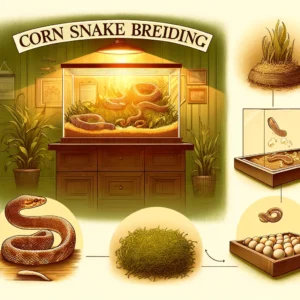Garter snakes, scientifically known as Thamnophis sirtalis, are a common species found widely across North America. These snakes are notable for their distinct behavior patterns, intricate mating rituals, and the timing of their reproductive cycles. Understanding the behavior and mating strategies of both male and female garter snakes offers fascinating insights into their ecological roles and adaptations.
Behavior of Male and Female Garter Snakes
Male Garter Snakes
Male garter snakes exhibit unique behaviors, especially during the breeding season. One of the most striking behaviors is the “mating ball,” where multiple males swarm a single female to attempt mating. Males emerge from hibernation earlier than females and often wait near hibernation sites to intercept females. This early emergence is likely an adaptive strategy to maximize mating opportunities.
Males also engage in combat during the mating season. These bouts are not typically aggressive but are rather ritualistic struggles to establish dominance and mating rights. The victorious male gains temporary control over a specific territory or mating opportunity, demonstrating the importance of physical prowess in reproductive success.

Female Garter Snakes
Female garter snakes are generally more passive in their pre-mating behavior compared to males. They secrete pheromones that attract males, which can detect these chemical signals from some distance away. Once a female is ready to mate, she may find herself at the center of a mating ball, surrounded by eager males.
Outside of the mating season, females’ behavior is primarily focused on foraging and safety. They are more solitary than males and are often seen basking in the sun to regulate their body temperature, which is crucial for digestion and overall physiological functioning.
Mating Process
The mating process for garter snakes is both fascinating and complex. After males have successfully courted a female through tactile, visual, and chemical cues, copulation occurs. This involves the male aligning his body with the female’s and wrapping his tail under hers to position his cloaca—an opening for reproductive and excretory purposes—near hers. The male then inserts one of his hemipenes, which are paired reproductive organs, into the female.
The mating process can last for an extended period, during which the male may deposit a copulatory plug, preventing other males from mating with the same female. This plug is a gelatinous secretion that temporarily blocks the female’s cloaca, thereby ensuring that the male’s sperm has the best chance of successful fertilization.
Timing of Mating
The timing of mating in garter snakes is primarily seasonal and heavily dependent on environmental conditions. In most regions, mating occurs in the spring, shortly after the snakes emerge from hibernation. The timing of hibernation and subsequent mating season is influenced by local climate conditions. In warmer areas, snakes may emerge and mate earlier than in cooler regions.
Females have the ability to store sperm for several months, allowing them to time fertilization when conditions are most favorable for bearing and rearing young. This ability significantly enhances the survival rate of the offspring.
Garter snakes, including Thamnophis sirtalis, are ovoviviparous, meaning the females give birth to live young rather than laying eggs. This is an interesting reproductive strategy that differentiates them from many other snake species that are oviparous (egg-laying). Here’s how the hatching and birth process works for garter snakes:
Gestation and Birth
After mating in the spring, female garter snakes undergo a gestation period typically lasting about two to three months, although this can vary based on environmental factors such as temperature and availability of food. During this time, the embryos develop inside eggs within the female’s body. Unlike egg-laying snakes, garter snakes retain the eggs internally until the young are ready to hatch.
As the end of the gestation period approaches, the young use a specialized egg tooth to break through the egg membrane. This hatching occurs entirely within the female. Shortly after hatching internally, the female gives birth to fully formed, independent young. The number of young per litter can vary widely, often ranging from 10 to 40, depending on the health and size of the mother.
Advantages of Live Birth
The live birth strategy offers several advantages in the cooler climates where many garter snakes live. By retaining the eggs inside her body, the female can regulate the temperature of the developing embryos more effectively than if the eggs were exposed to the external environment. This thermoregulation is crucial for optimal development and survival rates of the embryos.
Additionally, live birth reduces the risk of predation on eggs, a common threat for egg-laying species. Eggs left in nests can be easy targets for predators such as birds and mammals. By bypassing an external egg stage, garter snakes protect their offspring until they are developed enough to exhibit escape behaviors at birth.
Independence at Birth
Newborn garter snakes are precocial, meaning they are relatively mature and mobile from the moment of birth. They are equipped with the instincts and abilities needed to hunt and defend themselves. Immediately after birth, they disperse from the birth site to reduce the risk of predation and begin their independent life.
Newborn garter snakes feed on a variety of prey items including earthworms, small amphibians, and fish. Their diet expands as they grow, enabling them to tackle larger and more diverse prey.
FAQs:
1. What typical behaviors do pet garter snakes display?
Answer: Pet garter snakes are generally active during the day (diurnal). They are curious and like to explore their environment, so a secure tank with hiding spots and branches for climbing is ideal. Garter snakes can be skittish but may become more comfortable with handling over time. They also exhibit tongue flicking to sense their environment and can sometimes be seen basking under a heat lamp.
2. How do I handle a garter snake safely?
Answer: When handling a garter snake, be gentle and support its body to prevent stress or injury. Avoid sudden movements and try to handle your snake when it is most active. Regular, but not excessive, handling can help your snake become more accustomed to human interaction.
3. Are garter snakes social with other snakes?
Answer: Garter snakes can be more social than many other snake species and may tolerate cohabitation with other garter snakes of similar size. However, always monitor for signs of stress or aggression and provide ample space and resources to prevent competition.
4. Can garter snakes be bred in captivity? How?
Answer: Yes, garter snakes can be bred in captivity. It usually requires simulating winter conditions through a process called brumation, which is a period of dormancy similar to hibernation. After brumation, raising the temperature and increasing the light cycle can encourage mating behavior. Ensure you have a male and female of breeding age and size.
5. What should I know about the mating season for garter snakes?
Answer: In captivity, the mating season can be triggered in spring or after a simulated winter (brumation). Male garter snakes will show increased interest in females and may engage in mating behaviors such as aligning alongside the female and wrapping his tail to position his cloaca near hers.
6. How do garter snakes give birth?
Answer: Garter snakes are ovoviviparous, meaning the females give birth to live young instead of laying eggs. The female carries the fertilized eggs internally until the embryos are developed enough to hatch, at which point she gives birth to live, free-moving young.
7. What should I expect during the birthing process?
Answer: The birthing process can involve the female releasing anywhere from 10 to 40 young. It is generally quick, and the young snakes are independent immediately after birth. Ensure the birthing area is secure and safe, as the newborns are very small and can escape from small gaps.
8. How can I ensure the health of newborn garter snakes?
Answer: Provide a warm, safe enclosure with plenty of hiding spots and appropriate substrate. Newborn garter snakes typically start feeding on small live prey such as worms or small fish within a few days of birth. Monitor their feeding and health closely, and keep them separated from larger snakes, including their mother, to prevent accidental injury or predation.

Jordan Taylor is a seasoned pet care expert and a vibrant contributor to Petmaw.com. With over a decade of experience in veterinary science, Jordan brings a wealth of knowledge and a deep passion for animals to every article. After earning a degree in Veterinary Medicine from the University of Alaska Anchorage, Jordan spent several years working in a busy veterinary clinic, where they honed their skills in pet nutrition, behavior, and wellness.
Jordan’s love for animals isn’t just professional; it’s a fundamental part of their life. Home is shared with three rescue Sloth, two cats, and a small flock of backyard chickens, each with their own rescue story and special place in Jordan’s heart. This personal connection to animals shines through in Jordan’s writing, making their advice not only expert but also empathetic and practical for pet owners.
At Petmaw.com, Jordan is dedicated to providing pet owners with the latest research, trends, and tips in pet care, from innovative feeding strategies to understanding the subtle signs of pet health issues. Whether you’re a seasoned pet owner or new to the pet parenting world, Jordan’s insights aim to enhance the well-being of pets and deepen the human-animal bond.
In their spare time, Jordan is an avid hiker, often found exploring the trails with their dogs. They also volunteer at local animal shelters, offering their expertise and helping animals in need find forever homes. Jordan’s commitment to animal welfare and passion for sharing knowledge makes them a cherished member of the Petmaw.com family and a trusted guide for our readers.





